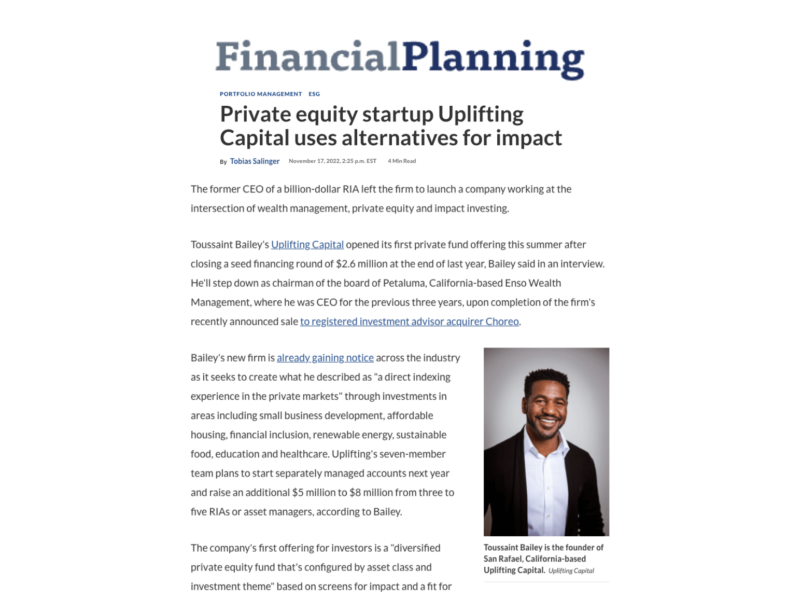Industry Update: Advancing Impact Reporting

The Need for High Quality Impact Reporting
High quality impact reporting can lead to greater effectiveness, transparency, and accountability, which, in turn, has the potential to improve a fund manager’s reputation as well as grow the impact investing industry as a whole. Without clear standards for how to report on impact, however, it can be difficult for investors to compare and contrast investments and evaluate successes and failures.
Many fund impact reports look like highlight reels. Impact results are provided for only a select number of investments, and impact risks and underperformance are often not addressed. The pressure to demonstrate positive impact can also lead to the reporting of vanity metrics – those that sound impressive but don’t provide insight into the true impact of an investment and lack actionable data.
As the impact investing industry matures, fund managers should expect growing pressure to provide comprehensive quantitative and qualitative impact results. While simply providing data about, for example, the number of students served through a particular investment perhaps used to be deemed sufficient for impact reporting, investors are beginning to demand detailed information about who or what is benefiting from an investment and to what degree. Who were the students being served – were they from traditionally underserved communities or students whose needs weren’t being met in their classrooms? How were they served, and did they experience meaningful, positive results?
In addition to providing robust impact results, fund managers should expect increased expectations regarding how these impact results are communicated. Investors value transparency and accountability and desire reliable evidence of how their capital is being invested for social and environmental impact.
Guidance from BlueMark: Best Practices and Verification Framework

Image Credit: Blue Mark
In an effort to advance the quality of impact reporting in the industry, BlueMark, a leading provider of impact investing verification, recently released a white paper detailing their framework for evaluating impact reports. Building off an earlier report summarizing the key elements of quality impact reporting in their “Raising the Bar” series, BlueMark’s latest report describes the criteria that form the basis for their impact reporting assessment and verification work. These two publications provide important guidance for fund managers looking to strengthen their impact reporting.
BlueMark outlines five key elements of quality impact reports: 1) defined objectives and expectations, 2) relevant metrics, 3) relative performance results, 4) integrated stakeholder perspectives, and 5) transparency into risk and lessons learned. In addition to incorporating all five key elements into reporting, fund managers should also consider the completeness and reliability of these elements in their impact reporting.
A high-quality impact report, according to BlueMark, provides a full and accurate look into a fund. Fund managers should disclose clear and consistent impact strategies, and reports should contain information about each investment as well as impact performance at both the portfolio and individual investment levels. Examples of best practices to ensure completeness of a fund manager’s reporting on its impact strategy and impact results include:
- Comprehensive impact theses that include impact risks
- Credible evidence supporting the impact strategy
- Standardized metrics – ideally tied to industry standards and external benchmarks
- Descriptions of and perspectives from relevant stakeholders
Reliability relates to the clarity and quality of the data in the impact report. In short, does the rigor of the fund manager’s impact management system lead to reliable data/results and is the fund manager’s reporting consistent with the underlying data/results? Examples of best practices to ensure the reliability and clarity of data contained in a report include:
- Disclosures relating to data sources, methodologies, assumptions, and limitations
- Reporting consistent with underlying data from a robust impact management system
- Quality control practices are in place and utilized
Uplifting’s Response: Sharpening Our Impact Reporting
At Uplifting Capital, we recognize the value of quality impact reporting and are committed to meaningful, transparent communications. As part of our efforts to increase integrity in the impact investing industry and provide meaningful information for our investors, Uplifting is incorporating BlueMark’s framework into our impact reports.
Our impact strategy, impact theses, and theory of change provide clear information about our impact goals and intentions. We align our investments to Sustainable Development Goals on a portfolio-level, and, when feasible, to IRIS+ metrics on an investment-level. This alignment and our progress are shared with investors in quarterly and annual impact reports. Uplifting nurtures a growth mindset, and we are committed to sharing our successes, failures, and lessons learned in our reporting.
We understand, however, that we have work to do. We analyze impact risks in our internal due diligence and are developing strategies to share this information externally as well. We are also working to incorporate more meaningful stakeholder perspectives in our reporting and improve our data quality controls.
Since a significant percentage of our portfolio consists of investments in impact funds, we are often reliant on impact data provided by other fund managers. To improve the quality of the underlying data we receive, Uplifting is developing and sharing impact tools and resources with our investees – both fund managers and companies.
Impact investing has the potential to advance innovative social and environmental solutions that will propel our planet and its people forward. High quality impact reporting with greater accountability and transparency can help stimulate the industry’s goal of financing a better world.
Sign up for Uplifting’s newsletter for more industry updates and analysis.
Investments in securities involves the risk of loss. Any mention of a particular security and related performance or impact data is not a recommendation to buy or sell that security. The information provided in the Uplifting Capital newsletter, podcast, social media channels or the www.upliftingcapital.com website (including any information that may be accessed through this website) is not directed at any investor or category of investors and is provided solely as general information.

